|
|
|
Sort Order |
|
|
|
Items / Page
|
|
|
|
|
|
|
| Srl | Item |
| 1 |
ID:
150020


|
|
|
|
|
| Summary/Abstract |
The register of the Dutch social housing stock was analysed, containing 300.000 dwellings, renovated between 2010 and 2013. The main objective was twofold: to evaluate the performance gap in these dwellings before and after the renovation and to establish what renovation measures achieve the highest reduction of consumption, particularly in practice (actual savings). The results showed large performance gaps in dwellings with low R and high U values, local heating systems, changes from a non-condensing into a condensing boiler and upgrades to a natural ventilation system. Regarding the actual effectiveness of renovation measures, replacement of old gas boilers with more efficient ones yields the highest energy reduction, followed by deep improvements of windows. Installing mechanical ventilation yields a small reduction compared to other measures, but still much larger than theoretically expected. The paper shows once more that the calculation method currently in use cannot be considered accurate if compared to actual consumption. The study demonstrated that unrealistic theoretical efficiencies of heating systems and insulation values are causing a part of the performance gap. Nowadays, large datasets of buildings thermal performance and actual consumption offer an opportunity to improve these misconceptions.
|
|
|
|
|
|
|
|
|
|
|
|
|
|
|
|
| 2 |
ID:
127907
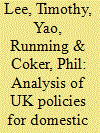

|
|
|
|
|
| Publication |
2014.
|
| Summary/Abstract |
This paper introduces a new agent-based model, which incorporates the actions of individual homeowners in a long-term domestic stock model, and details how it was applied in energy policy analysis. The results indicate that current policies are likely to fall significantly short of the 80% target and suggest that current subsidy levels need re-examining. In the model, current subsidy levels appear to offer too much support to some technologies, which in turn leads to the suppression of other technologies that have a greater energy saving potential. The model can be used by policy makers to develop further scenarios to find alternative, more effective, sets of policy measures. The model is currently limited to the owner-occupied stock in England, although it can be expanded, subject to the availability of data.
|
|
|
|
|
|
|
|
|
|
|
|
|
|
|
|
| 3 |
ID:
124610
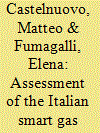

|
|
|
|
|
| Summary/Abstract |
The introduction of smart metering is one of the core elements in recent European policies targeting environmental sustainability and competitiveness of energy markets. Following the roll-out of smart electricity meters, in 2008 the Italian regulator designed an ambitious deployment program also for smart gas meters, that was recently modified in both scope and timing.
This paper assesses Italy's original and current deployment plans, with a specific focus on the results of its cost-benefit analysis. In light of the evidence derived from the literature, we observe that the case for the roll-out of smart gas meters in Italy was not supported by a strong emphasis on energy savings but rather focused on increasing efficiency of the Italian gas market; in this respect, we argue that options other than smart gas metering should also be considered. Moreover the Italian cost-benefit analysis, which mostly dealt with the potential cost savings for distributors and suppliers, led to ambiguous results in terms of net present values; thus, we believe that an updated assessment would be extremely useful. Finally, in terms of technological choices, our analysis positively evaluates the regulator's recent proposal to consider a dual-fuel solution for the mass market deployment.
|
|
|
|
|
|
|
|
|
|
|
|
|
|
|
|
| 4 |
ID:
127911


|
|
|
|
|
| Publication |
2014.
|
| Summary/Abstract |
Wind energy has been negotiated in Brazil's regulated market through auctions organized by the government. Bilateral negotiations in the free market have been scarce. In 2011 wind farms were allowed to bid in 'A minus 5 (A?5)' auctions, for energy with first delivery date 5 years ahead. This new design was expected to stimulate negotiations in the free market, as the 20-year contract in the regulated market eases financing while the 5-year grace period grants wind farms the option to sell whatever energy is generated beforehand in the free market. We modeled bidders' price decision in A?5 auctions as Real Options and concluded that given the low prices averaging USD 50/MW h, winners are tempted to defer investment, expecting more favorable equipment and energy prices, or a better knowledge of the wind site. Construction is likely to begin in 2-3 years, with little time left for the free market. Bidders that consider the option of eventually abandoning the project are more price competitive, increasing chances that some wind farms will never materialize. Therefore, this attempt to foster the free market may not pay-off and, moreover, it may have the unfavorable effect of turning Brazil's energy expansion planning a more difficult task.
|
|
|
|
|
|
|
|
|
|
|
|
|
|
|
|
| 5 |
ID:
127236


|
|
|
|
|
| Publication |
2014.
|
| Summary/Abstract |
While almost 30% of UK households include children, little research has attempted to present children's perspectives on home energy use. This study used focus groups with children and parents at two primary (elementary) schools in London, UK, to explore home energy use and energy feedback. Energy was found to be a little-discussed subject at home. Children derived more motivation to save energy from responsibility conferred by school activities than other (e.g. environmental) concerns, and some connected energy saving with dangers of using electricity (e.g. fire). Material and social constraints (e.g. access to outside space, parents' environmental attitudes) meant that it was sometimes difficult for children to save energy even when motivated. However, parents showed greater inclination to pay attention to energy saving when framed as supporting their child's learning than as a financial or environmental concern. Children were disinclined to reduce energy-consuming activities such as watching television, and while parents complained about children's energy use most saw it as a low priority issue. Policy implications of these findings are considered, and the approach employed is argued to be an effective way of investigating children's perceptions around energy use.
|
|
|
|
|
|
|
|
|
|
|
|
|
|
|
|
| 6 |
ID:
162795
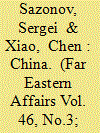

|
|
|
|
|
| Summary/Abstract |
China's rapid economic development over the past three decades has multiplied power consumption, while the population's income growth has stimulated a dramatic increase in the production and sales of cars. These factors have increased the country's dependence on imports of petroleum products and deteriorated the environmental situation in the PRC. Being aware of these challenges, the government is radically reorganizing the automotive industry on the basis of new energy, creating an innovative motor vehicle fleet and corresponding new-generation infrastructure.
|
|
|
|
|
|
|
|
|
|
|
|
|
|
|
|
| 7 |
ID:
099256
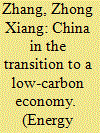

|
|
|
|
|
| Publication |
2010.
|
| Summary/Abstract |
China, from its own perspective cannot afford to and, from an international perspective, is not allowed to continue on the conventional path of encouraging economic growth at the expense of the environment. Instead, China needs to transform its economy to effectively address concern about a range of environmental problems from burning fossil fuels and steeply rising oil import and international pressure on it to exhibit greater ambition in fighting global climate change. This paper first discusses China's own efforts towards energy saving and pollutants cutting, the widespread use of renewable energy and participation in clean development mechanism, and puts carbon reductions of China's unilateral actions into perspective. Given that that transition to a low carbon economy cannot take place overnight, the paper then discusses China's policies on promoting the use of clean coal technologies and nuclear power. Based on these discussions, the paper provides some recommendations on issues related to energy conservation and pollution control, wind power, nuclear power and clean coal technologies and articulates a roadmap for China regarding its climate commitments to 2050.
|
|
|
|
|
|
|
|
|
|
|
|
|
|
|
|
| 8 |
ID:
131400
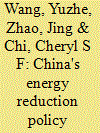

|
|
|
|
|
| Publication |
2014.
|
| Summary/Abstract |
The paper examines the outcomes of and responses to the policy system (the "obligatory indicator system") used by the Chinese central government to induce provincial governments to meet energy-saving targets during the 11th Five Year Plan. The institutional mechanisms underlying the policy system that promotes implementation of energy saving are identified An analytical framework is developed to identify the strategic responses of provincial governments and the factors shaping their responses. Comprehensive sets of provincial data on economic and energy performance are collected and analyzed. The findings indicate that the central government's credible commitment to implement the policy system drove the initially disparate attitudes of provinces to a converged outcome. However, the outcome is significantly constrained by provinces' initial energy intensity. In particular, provincial governments have applied strategies of ceremonial implementation, efficiency-oriented efforts and effectiveness-focused efforts to attain specific targets. This paper discusses the implications in comparison with the modified obligatory indicator system in the 12th Five Year Plan and offers policy suggestions accordingly.
|
|
|
|
|
|
|
|
|
|
|
|
|
|
|
|
| 9 |
ID:
121315
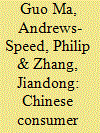

|
|
|
|
|
| Publication |
2013.
|
| Summary/Abstract |
Energy saving is now an important component of China's energy policy. This paper reports the findings of a survey carried out in 2009 and 2010 of 246 citizens at different locations in the municipality of Chongqing in order to reveal information about attitudes towards energy and energy saving in the context of household electrical appliances. This study shows that citizens in Chongqing receive relatively little information and guidance on how to save energy in the home and that their stated level of knowledge on this subject is also rather limited. Respondents showed some willingness to save energy as long as this did not reduce their comfort and convenience, and they appeared likely to respond to economic incentives, such as high electricity prices or discounts on appliances. But they seemed to be unaware of the potential for information to help them save energy. The survey also demonstrated a high degree of heterogeneity across society with respect to sources of information and trust in those sources and with respect to attitudes to energy saving at home. These results show that the government needs to substantially adjust its strategies for promoting household energy saving.
|
|
|
|
|
|
|
|
|
|
|
|
|
|
|
|
| 10 |
ID:
116951
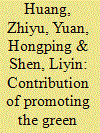

|
|
|
|
|
| Publication |
2012.
|
| Summary/Abstract |
Green residence development has been one of the important strategies for promoting sustainable urban development. Governments throughout the world have been encouraging property developers to deliver green properties. In line with this development, governments have been implementing various assessment programs to certify green residential buildings with the aim of contributing to sustainable urban development. With reference to the Chinese construction practice, this paper examines the effectiveness of the green residence assessment scheme toward its defined aim through investigating the contents and procedures of the green residence assessment scheme by referring to the practices of Chongqing city in western China. Based on the results of five case studies and five semi-structured interviews, this study reveals the significant contribution from implementing the green residence assessment scheme particularly to energy saving in residential buildings. Further, the green residence assessment scheme promotes the application of green building materials and green construction technologies in the entire process of delivering and operating residential buildings. The findings provide valuable references for further investigating alternative methods to achieve better energy saving in developing residential buildings.
|
|
|
|
|
|
|
|
|
|
|
|
|
|
|
|
| 11 |
ID:
104809
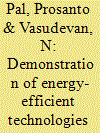

|
|
|
| 12 |
ID:
109425
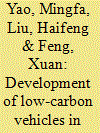

|
|
|
|
|
| Publication |
2011.
|
| Summary/Abstract |
Reducing CO2 emissions from vehicles in China is crucial and will significantly alleviate the environmental burden of the Earth. Some promising technologies that make possible low-carbon vehicles are reviewed in this work, including electric vehicles, fuel cell vehicles, hybrid vehicles, biofuels vehicles, other alternative fuel vehicles, and conventional internal combustion engine vehicles with improvement. In the short term, expanding the use of mature technologies in conventional gasoline or diesel vehicles is the most realistic, effective, and timely solution for China to meeting the urgent challenges of energy saving and greenhouse gas reduction; while in the long run biofuel is a promising candidate due to their renewability and carbon neutrality. The blueprint of low-carbon vehicles for China depends on three aspects: breakthroughs in technology, awareness of public, and government guidance.
|
|
|
|
|
|
|
|
|
|
|
|
|
|
|
|
| 13 |
ID:
119814
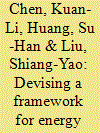

|
|
|
|
|
| Publication |
2013.
|
| Summary/Abstract |
Research has indicated that incorporating carbon reduction in the curriculum could improve awareness about energy conservation and related practices. Much research has been conducted on curriculum design and evaluation methods for energy education. However, a comprehensive view of the educational objectives for improving energy literacy is still lacking in these efforts. In this study, we propose a framework for energy education that clearly captures the concept of energy saving and carbon reduction by reviewing related literature and consulting an ad hoc panel of experts on energy and education. We then apply the analytic hierarchy process (AHP) to determine the indicators of the framework and their priority or weights. The results show that the dimensions of "civic responsibility for a sustainable society" and "low-carbon lifestyle" are considered most important as an energy educational goal. Among the indicators, "awareness and self-efficacy" and "identifying carbon-less technology and action plans" are ranked first and second. Application of this framework in K-12 curriculum and relevant educational issues are recommended.
|
|
|
|
|
|
|
|
|
|
|
|
|
|
|
|
| 14 |
ID:
132677


|
|
|
|
|
| Publication |
2014.
|
| Summary/Abstract |
In this paper we analyze the effect of regional and municipal measures for promoting energy transition on citizen attitudes and behavior. We compare one township that has successfully implemented a comprehensive and systematic energy-saving program (the so-called e5 program) with a township without such a program. The results indicate that despite the program×s ambitious aims, e5 implementation has almost no impact on citizen attitudes and behavior. In fact, there are some signs that it might even have slight negative side effects.
|
|
|
|
|
|
|
|
|
|
|
|
|
|
|
|
| 15 |
ID:
085613
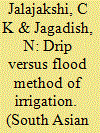

|
|
|
| 16 |
ID:
166398
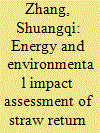

|
|
|
|
|
| Summary/Abstract |
The utilization of straw plays an important role in China's sustainable development. Returning straw to fields as organic fertilizer (straw return) and processing straw into straw briquette fuel (SBF) are two of the most promising methods for employing straw; however, there is a lack of information with respect to comparing these two methods. Therefore, a case study was conducted in Heilongjiang Province to estimate the energy and environmental impacts of straw return and the substitution of SBF for rural heating coal. This study aims to provide policymakers with useful information and to encourage rational decision-making regarding the efficient utilization of straw resources. Results showed that both straw return and substituting SBF for rural heating coal could have significant impacts on energy and the environment, while substituting SBF for rural heating coal had advantages over straw return in all aspects. Moreover, substituting SBF for rural heating coal was more acceptable to famers, and thus was easier to promote and could resolve the problem of open straw burning more effectively than straw return. Therefore, greater attention should be paid to SBF utilization, especially in rural areas. Results of this study can also benefit other regions to improve the utilization of straw resources.
|
|
|
|
|
|
|
|
|
|
|
|
|
|
|
|
| 17 |
ID:
150878


|
|
|
|
|
| Summary/Abstract |
Building sector consumes a significant amount of energy worldwide (up to 40% of the total global energy); moreover, by the year 2030 the consumption is expected to increase by 50%. One of the reasons is that the performance of buildings and its components degrade over the years. In recent years, energy benchmarking for government office buildings, large scale public buildings and large commercial buildings is one of the key energy saving projects for promoting the development of building energy efficiency and sustainable energy savings in Gulf Cooperation Council (GCC) countries. Benchmarking would increase the purchase of energy efficient equipment, reducing energy bills, CO2 emissions and conventional air pollution. This paper focuses on energy benchmarking for shopping centers in Gulf Coast Region. In addition, this paper will analyze a sample of shopping centers data in Gulf Coast Region (Dubai, Ajman, Sharjah, Oman and Bahrain). It aims to develop a benchmark for these shopping centers by highlighting the status of energy consumption performance. This research will support the sustainability movement in Gulf area through classifying the shopping centers into: Poor, Usual and Best Practices in terms of energy efficiency. According to the benchmarking analysis in this paper, the shopping centers best energy management practices in the Gulf Coast Region are the buildings that consume less than 810 kW h/m2/yr, whereas the poor building practices are the centers that consume greater than 1439 kW h/m2/yr. The conclusions of this work can be used as a reference for shopping centres benchmarking with similar climate.
|
|
|
|
|
|
|
|
|
|
|
|
|
|
|
|
| 18 |
ID:
098210


|
|
|
|
|
| Publication |
2010.
|
| Summary/Abstract |
In this paper, Shanghai's CO2 emissions from 1995 to 2006 were estimated following the IPCC guidelines. The energy demand and CO2 emissions were also projected until 2020, and the CO2 mitigation potential of the planned government policies and measures that are not yet implemented but will be enacted or adopted by the end of 2020 in Shanghai were estimated. The results show that Shanghai's total CO2 emissions in 2006 were 184 million tons of CO2. During 1995-2006, the annual growth rate of CO2 emissions in Shanghai was 6.22%. Under a business-as-usual (BAU) scenario, total energy demand in Shanghai will rise to 300 million tons of coal equivalent in 2020, which is 3.91 times that of 2005. Total CO2 emissions in 2010 and 2020 will reach 290 and 630 million tons, respectively, under the BAU scenario. Under a basic-policy (BP) scenario, total energy demand in Shanghai will be 160 million tons of coal equivalent in 2020, which is 2.06 times that of 2005. Total CO2 emissions in 2010 and 2020 in Shanghai will be 210 and 330 million tons, respectively, 28% and 48% lower than those of the business-as-usual scenario. The results show that the currently planned energy conservation policies for the future, represented by the basic-policy scenario, have a large CO2 mitigation potential for Shanghai.
|
|
|
|
|
|
|
|
|
|
|
|
|
|
|
|
| 19 |
ID:
098540


|
|
|
|
|
| Publication |
2010.
|
| Summary/Abstract |
In this paper, Shanghai's CO2 emissions from 1995 to 2006 were estimated following the IPCC guidelines. The energy demand and CO2 emissions were also projected until 2020, and the CO2 mitigation potential of the planned government policies and measures that are not yet implemented but will be enacted or adopted by the end of 2020 in Shanghai were estimated. The results show that Shanghai's total CO2 emissions in 2006 were 184 million tons of CO2. During 1995-2006, the annual growth rate of CO2 emissions in Shanghai was 6.22%. Under a business-as-usual (BAU) scenario, total energy demand in Shanghai will rise to 300 million tons of coal equivalent in 2020, which is 3.91 times that of 2005. Total CO2 emissions in 2010 and 2020 will reach 290 and 630 million tons, respectively, under the BAU scenario. Under a basic-policy (BP) scenario, total energy demand in Shanghai will be 160 million tons of coal equivalent in 2020, which is 2.06 times that of 2005. Total CO2 emissions in 2010 and 2020 in Shanghai will be 210 and 330 million tons, respectively, 28% and 48% lower than those of the business-as-usual scenario. The results show that the currently planned energy conservation policies for the future, represented by the basic-policy scenario, have a large CO2 mitigation potential for Shanghai.
|
|
|
|
|
|
|
|
|
|
|
|
|
|
|
|
| 20 |
ID:
088198
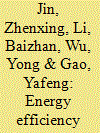

|
|
|
|
|
| Publication |
2009.
|
| Summary/Abstract |
This paper discusses energy consumption, building development and building energy consumption in China, and points that energy efficiency management and maintenance of large-scale public buildings is the breakthrough point of building energy saving in China. Three obstacles are lack of basic statistics data, lack of service market for building energy saving, and lack of effective management measures account for the necessity of energy efficiency supervision for large-scale public buildings. And then the paper introduces the supervision aims, the supervision system and the five basic systems' role in the supervision system, and analyzes the working mechanism of the five basic systems. The energy efficiency supervision system of large-scale public buildings takes energy consumption statistics as a data basis, Energy auditing as a technical support, energy consumption ration as a benchmark of energy saving and price increase beyond ration as a price lever, and energy efficiency public-noticing as an amplifier. The supervision system promotes energy efficiency operation and maintenance of large-scale public building, and drives a comprehensive building energy saving in China.
|
|
|
|
|
|
|
|
|
|
|
|
|
|
|
|
|
|
|
|
|